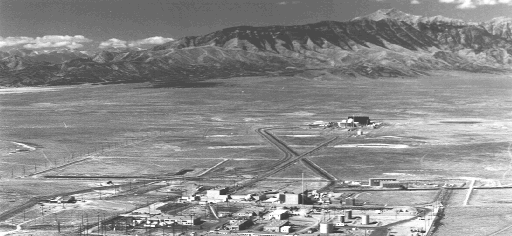Nuclear Aircraft Powerplant Experiments
The map below shows the Idaho National Engineering and Environmental Laboratory (INEEL), where NEPA powerplant experiments were conducted in the 1950s.
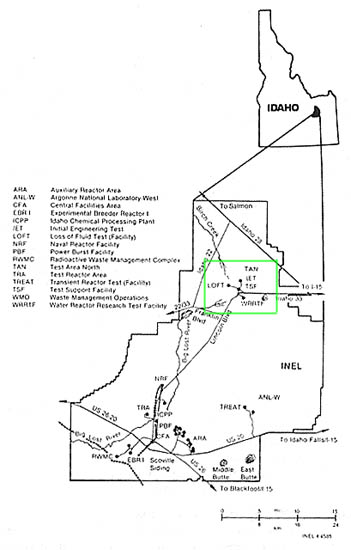
INEEL (established in 1949 as the National Reactor Testing Station) Test Area North (above) was the site of Heat Transfer Reactor Experiments -- "HTRE" -- aircraft nuclear engine prototype ground-based testing, which began in 1955. The nuclear-powered aircraft prototype would have been flown from here. A huge hangar was constructed (black building, center right), but not the fifteen thousand foot runway that a ponderous nuclear plane would have required. A multi-mile runway for the X-6 reportedly was also considered at Edwards Air Force Base, California, running between Muroc dry lake and Rosamond dry lake, but it too was never built.
The hangar and associated maintenance facilities were built with enormously thick, nuclear-shielded walls and bays. General Electric, the program contractor, planned to equip the engine maintenance facilities with closed-circuit television systems and remote manipulator arms to allow technicians to work on the aircraft and its powerplant without direct exposure to the intense radiation field that would persist even after the reactor was shut down. Since the turbojets essentially functioned as the cooling system for the reactor, they would have to be run at high power settings even after shutdown of the reactor in order to maintain cooling airflow through the still-hot core. After an initial cooldown period, ground cooling systems would be connected to the reactor and the engines could be shut down as the P-1 was extracted from the airplane and placed in its shielded storage bay.
The initial HTRE engine experiments were intended to prove out the engineering and operational concepts for a nuclear bomber powerplant, but without the restrictions on weight and size that an airplane powerplant would demand. These early assemblies were gigantic monstrosities weighing at least a hundred thousand pounds, and were built on railcars which would move them to remote test locations far from their assembly, maintenance and control facilities. When the engineering aspects of the designs were proven, the next step would be to reduce the size of the designs while increasing their power output, with the goal of producing a final, operational version of the design that would be "flightweight" and "flightsize" with a thermal output of at least 50 megawatts. This was to be done in stages over a several year period.
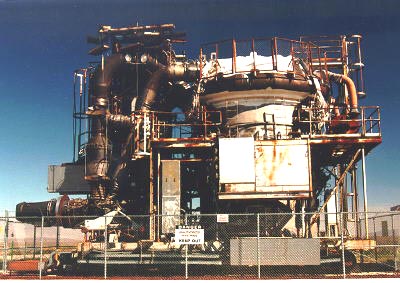 |
HTRE-1, also known as the Core Test Facility, the initial aircraft engine/reactor testbed, was mounted on a huge mobile railroad car assembly. It was a water-moderated uranium reactor with a beryllium reflector and shielding that included large quantities of mercury. The two jet engines just visible at lower left would be started using hot gas produced by chemical-fuel combustors. Once the jets were running at speed, the reactor would be brought up to power and airflow would be established through the core. Its heat would then be gradually diverted to the jet turbines as the gas combustor flow was phased out. The jets would be run on nuclear-heated air for periods of hours at a time to simulate the operation of a long-duration nuclear aircraft powerplant. Post-shutdown, the reactor's railcar would be returned to a maintenance bay for disassembly and analysis. HTRE-1 reached power levels as high as 20.2 megawatts. It was later modified to become HTRE-2 and was used for testing special reactor core configurations and materials, reaching power levels of around 14 megawatts
|
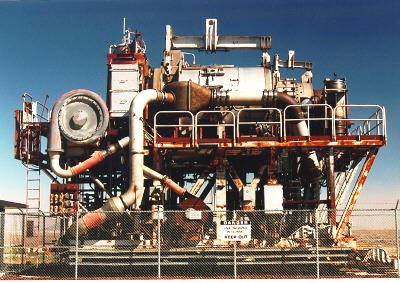 |
HTRE-3
images courtesy Bureau of Atomic Tourism |
General Electric began HTRE-1 test runs in 1955 and the reactor successfully powered the X39 engines the following year, although the massive contraption was far from a practical aircraft powerplant. However, HTRE-3 was a major step toward a flight-capable nuclear engine, which would have been designated "XNJ140E-1." According to a program history,
the dimensions of the core and its structural characteristics as well as the design temperatures were those of a power plant capable of providing useful flight propulsion. The power generated by HTRE No. 3 ranged up to 35 megawatts...In the HTRE No. 3 tests, the power levels were so chosen that the fuel element temperatures, the key parameter, would be characteristic of flight service.
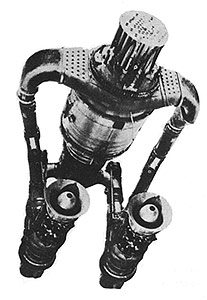 |
HTRE-3, without its test structure, closely resembled the original GE P-1 reactor/engine complex concept. Its horizontal layout and lightweight solid hydrided zirconium moderator, as well as its flightweight core and aluminum structural components, were intended to simulate an operational flight reactor. Its size and configuration appear to have been designed with the B-36 or B-60 in mind. HTRE-3 was operated at the National Reactor Testing Station from April 1958 through December 1960. It appears that, having solved the aircraft reactor shielding problem and successfully operated a 35 megawatt, flightweight nuclear turbojet powerplant that probably could have propelled an aircraft (at least well enough to impress congressional program critics), the Aircraft Nuclear Propulsion project came rather close to fulfilling the original NEPA design goals of the late 1940s --and in spite of numerous program delays, redirections and even cancellations, it succeded in doing so well within the 15-year period envisioned by the 1948 MIT Lexington Project feasibility study. Nevertheless, the ANP program was cancelled by the new Kennedy administration on March 28, 1961. If HTRE-3 had existed in 1952, an operational model undoubtedly would have flown in an aircraft, but by 1961 the very existence of manned bombers was threatened by the cheaper, faster and relatively invulnerable ICBM. The large nuclear airplane engine had lost its raison d'etre in the Kennedy/McNamara era |
